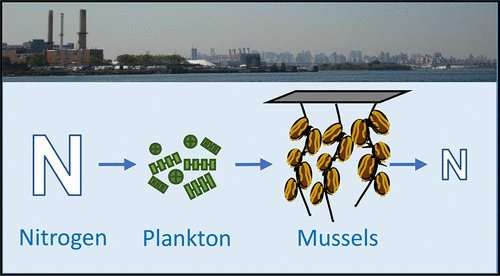Cleaning up Aquatic Pollution with Mussels
Published on by Water Network Research, Official research team of The Water Network in Academic
Scientists and activists alike have been looking for a solution to the problem of aquatic nutrient pollution. Now one group reports in Environmental Science & Technology that ribbed mussels are up to the clean-up challenge.

Source: ACS
When it comes to nutrients, like nitrogen and phosphorus, too much of a good thing can be bad. These nutrients end up in rivers and streams as the result of human activities and can cause algal blooms, loss of seagrass and low oxygen levels, which can lead to large numbers of fish and other organisms dying.
Many studies have examined how to prevent this runoff, but not much attention has been paid to removing the nutrients from the water. Some agencies have started programs to do this, and they are using shellfish to filter out unwanted substances.
Geukensia demissa, known as the ribbed mussel, is one type of shellfish proposed for these programs. This mussel lives in various habitats and can filter bacteria, microalgae, and detritus containing nutrients and contaminants. In addition, this shellfish is not for sale on the commercial market, so these mussels aren’t directly consumed by humans.
To see whether G. demissa could clean up dirty water in an urban environment, Julie Rose, Eve Galimany and colleagues conducted a pilot experiment.
The team equipped and deployed a raft stocked with local ribbed mussels in late June 2011 in an estuary at an industrial setting near New York City. The raft is a floating platform with beams and underwater ropes to which the mussels attach. The next spring, the researchers harvested the raft and studied the mussels.
Overall, the mussels were healthy, and their tissues had high amounts of a local nitrogen isotope, indicating that they removed nitrogen from the water. Based on their study, the group estimates that a fully stocked raft would clean an average of 3 million gallons of water and remove about 350 pounds of particulate matter, like dust and soot, daily. In addition, they also determined that 138 pounds of nitrogen were potentially removed when the animals were harvested.
The authors acknowledge funding from the New York State Office of the Attorney General and National Oceanic and Atmospheric Administration’s Office of Aquaculture.
Source: American Chemical Society
Media
Taxonomy
- Treatment
- Treatment Methods
- Biological Treatment
- Biological & Chemical Quality
- Resource Management
- Biological Treatment